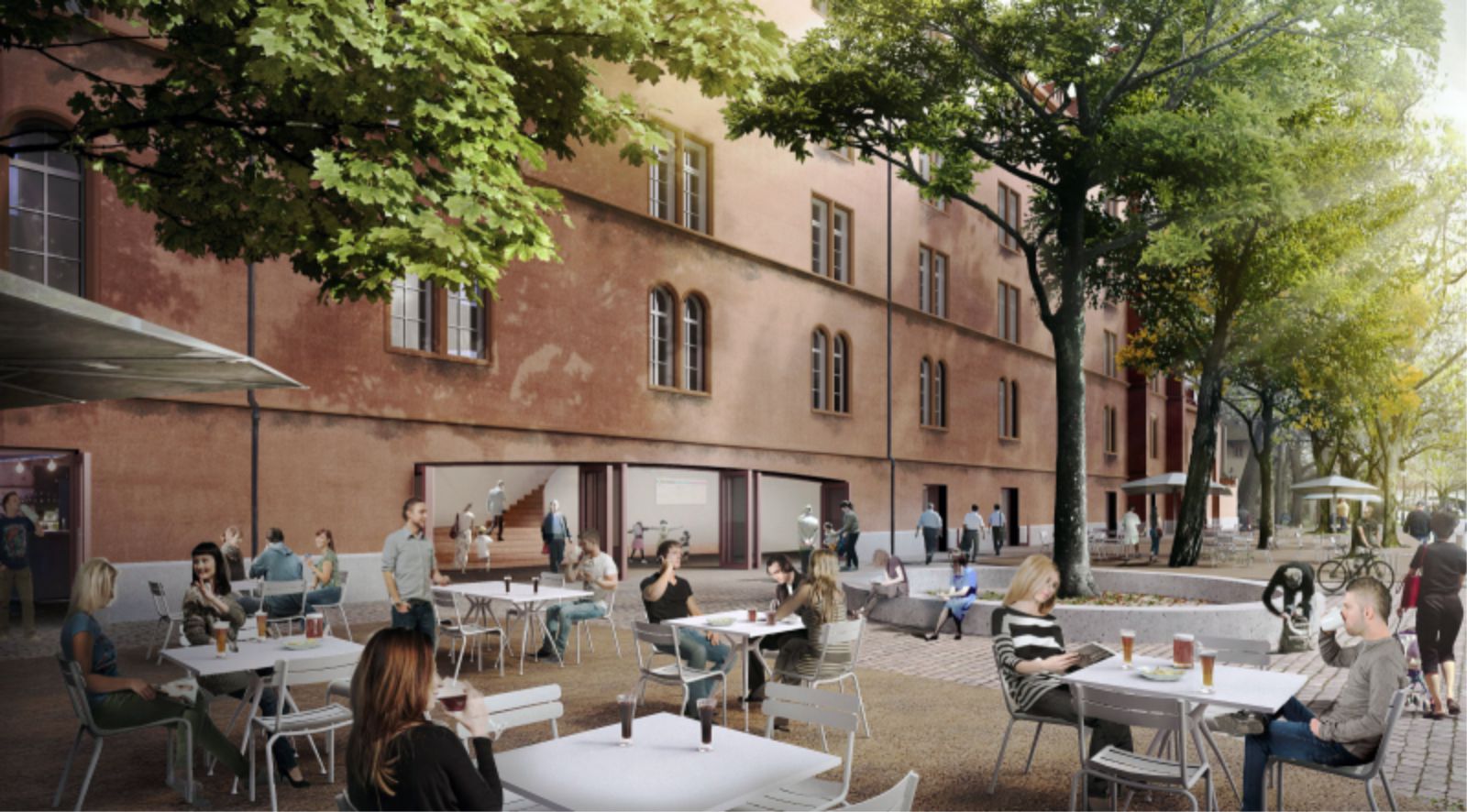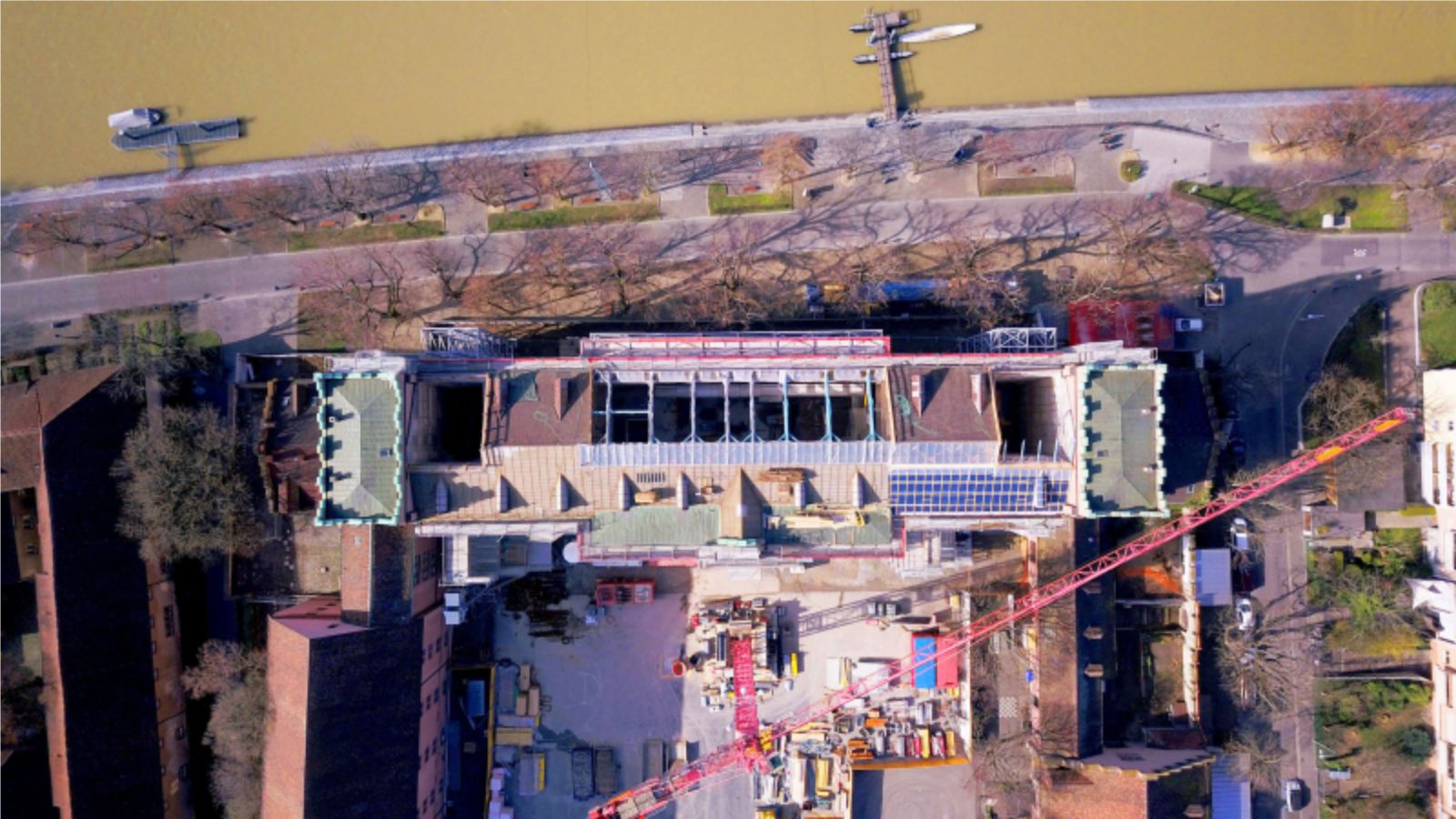Currently under construction, the 9,000 m2 conversion, designed by FOCKETYN DEL RIO , will create a new public nexus in the heart of Basel. This future landmark unites and unlocks two previously disconnected and enclosed spaces on the Rhine River. Kaserne Cultural Center will provide the town with a contemporary and multifunctional cultural facility that generates new public areas and gathering places in a historic location.
Kaserne Area Basel – Past and Present
Kaserne is one of Basel’s essential cultural and communal spaces, popular across diverse communities in the city as well as the metropolitan regions of Switzerland, France, and Germany. The area already hosts several cultural facilities, including the largest center for dance, contemporary theatre, performance, and music in northwestern Switzerland; a multifunctional music and events space and several restaurants and bars, all adjacent to a large, public park.
150 years ago, the Swiss army built this complex for military use in the core of the city, in 1966 the army abandoned the site. A joint committee of government and local community representatives decided not to alter these structures, but to use them for a wide range of cultural, educational, artistic, and communal activities. By letting the area grow organically over several decades, it became embedded in the city’s landscape as a cherished social hub.
Until now, it managed to maintain a vibrant communal life without architectural intervention by reallocating the functions of the buildings. The largest building of the complex never went through this process of appropriation. Located at the far end of the site and blocking access to the Rhein, it kept its bureaucratic role and did not partake in this social transformation, despite being the primary edifice in the compound. Thus far, the waves of change have crashed against a single building–this monolithic bulwark. FOCKETYN DEL RIO’s plan to convert this site ensures a sensitive and sustainable transformation of a gathering place in the heart of the city.
A mute Building starts to speak
FDRS’ project turns a previously defunct building into an urban nexus which links the Kaserne area with the Rhein, generating a plethora of public spaces. In a nod to the building and the site’s history, FDRS perceptively refreshes its exterior, keeping the essence and substance intact. “When we found the building, it was too shy to open itself up to the river. With our intervention, we only realize the potential that has always been there – the building invited us to do exactly what we are doing. It is not our aim to be noticed: we are convinced that once the transformation is complete, you will forget how it was before.”
The center of the building is becoming a large, indoor public space, named the Plaza. The site’s nucleus, this threestory high open space, will become both its central circulation core and the public gateway from the Rhine to the building and into the park. Addressing the need to integrate several new pathways with the two sides of the building, FDRS is introducing two additional passages on the periphery of the structure and enlarging all ground floor windows to become doors, making the building open, porous, accessible, and filled with life which spills out into the city.
On the inside: Conceptual Adaptability and Flexibility of Use
Continuing its trademark of a sensitive and sustainable approach to design, FDRS astutely introduces radical transformations on the inside of Kaserne Cultural Center. Pragmatic and flexible uses, adaptable and ready for the future, are achieved by a “poly-typology” of rooms. Rooms can become corridors, and corridors can become rooms, giving the interior Tetris-like scalability via a unique plug-and-play configurability. Circulation becomes ubiquitous, generating constant flow that is further organized by the introduction of two vertical stairways in favor of long corridors.
Located in the Plaza, the central staircase is generated by rotating the building’s core. Though unified as a single structure, the interior of the Kaserne Cultural Center is defined by its plurality and versatility: In its center is the public Plaza, and directly above, an events and performance space, art and rehearsal studios, a matrix of multi-functional rooms, restaurants, dining areas, and local spaces of worship, all connected by the central plaza and three vertical stairways.
A future Landmark for Basel, a new Place of encounter
A building that used to be a barrier will soon become open, accessible, and filled with life. The 45 million CHF transformation is the city’s very first publicly funded investment of a large-scale cultural facility in the Kleinbasel district. As one of the up-and-coming areas of Basel, the building is set to profoundly and positively change this region. Kaserne Cultural Center, a vanguard of this future development, will become a magnet for the city and a beacon of its inclusive and multicultural orientation. Source by FOCKETYN DEL RIO.

Diagram Uses
- Location: Basel, Switzerland
- Architect: FOCKETYN DEL RIO
- Client: Hochbauamt Basel Stadt
- Project Type: Cultural Center, Mixed Use
- Size: 9000m2
- Completion: 2021
- Images: Courtesy of FOCKETYN DEL RIO






